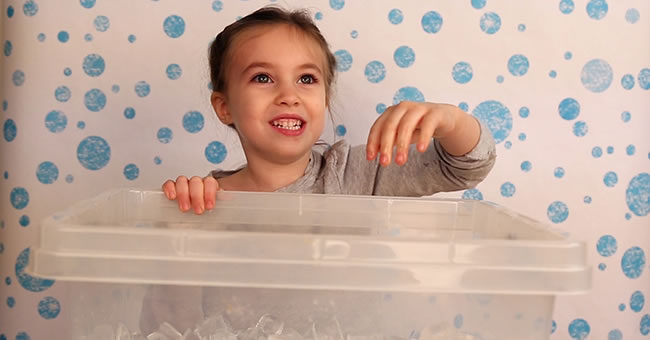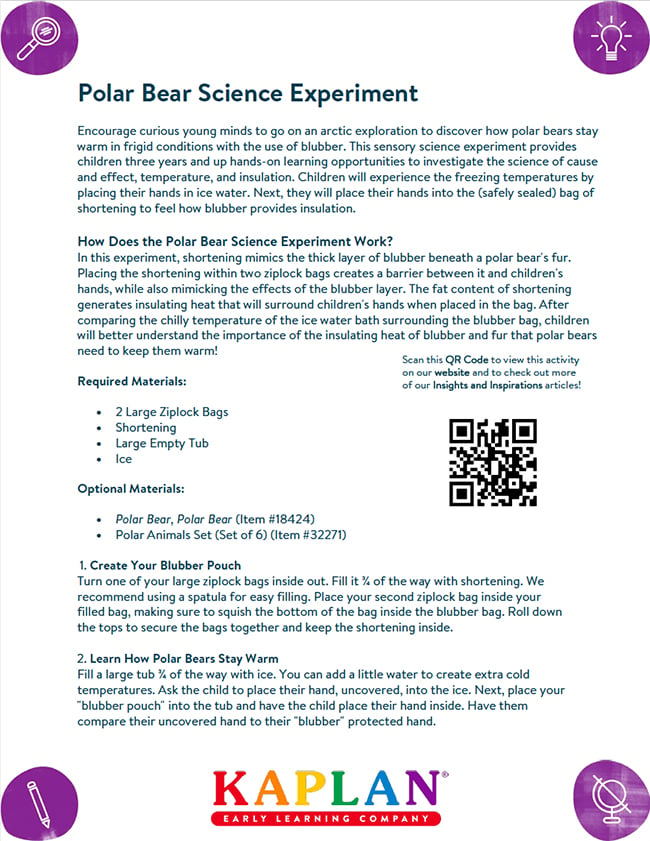
Encourage curious young minds to go on an arctic exploration to discover how polar bears stay warm in frigid conditions with the use of blubber. This sensory science experiment provides children three years and up hands-on learning opportunities to investigate the science of cause and effect, temperature, and insulation. Children will experience the freezing temperatures by placing their hands in ice water. Next, they will place their hands into the (safely sealed) bag of shortening to feel how blubber provides insulation.
Early educators can include the Polar Bear Science Experiment in small groups to inspire learning opportunities via the six steps of the scientific method by prompting preschoolers to ask, imagine, plan, create, improve, and share. It's important to include the real-time experience of hands-on science in the classroom to help children to think critically and engage with their surroundings to better understand the applicability of the experiment to real life. This method of inquiry can prompt young learners to investigate the how, why, what if, and I wonder type of questions within the context of this experiment. Learning is extended when paired with Polar Bear, Polar Bear, to integrate language, literacy, and creativity.
Download our FREE printable below!

How Do Polar Bears Stay Warm?
Polar bears are warm-blooded, meaning they maintain a high body temperature regardless of the temperature of their surrounding environment. In order to keep warm in the chilly temperatures of the Arctic, many mammals are equipped with thick layers of blubber (or fat) that is covered by fur to insulate their body temperature to help keep them warm on even the coldest days. Think of it like when we wear a thick sweater under a puffy, warm coat on a frigid winter day. The thick layers allow us to insulate our body and maintain the heat we generate, rather than exposing it to the cold.
How Does the Polar Bear Science Experiment Work?
In this experiment, shortening mimics the thick layer of blubber beneath a polar bear's fur. Placing the shortening within two ziplock bags creates a barrier between it and children's hands, while also mimicking the effects of the blubber layer. The fat content of shortening generates insulating heat that will surround children's hands when placed in the bag. After comparing the chilly temperature of the ice water bath surrounding the blubber bag, children will better understand the importance of the insulating heat of blubber and fur that polar bears need to keep them warm!
Required Materials:
- 2 Large Ziplock Bags
- Shortening
- Large Empty Tub
- Ice
Optional Materials:
1Create Your Blubber Pouch
Turn one of your large ziplock bags inside out. Fill it ¾ of the way with shortening. We recommend using a spatula for easy filling. Place your second ziplock bag inside your filled bag, making sure to squish the bottom of the bag inside the blubber bag. Roll down the tops to secure the bags together and keep the shortening inside.
2Learn How Polar Bears Stay Warm
Fill a large tub ¾ of the way with ice. You can add a little water to create extra cold temperatures. Ask the child to place their hand, uncovered, into the ice. Next, place your "blubber pouch" into the tub and have the child place their hand inside. Have them compare their uncovered hand to their "blubber" protected hand.
Include the Polar Bear Science Experiment in your classroom to encourage early exposure to hands-on science opportunities.
Be sure to browse our list of science-related products, resources, and professional development.
